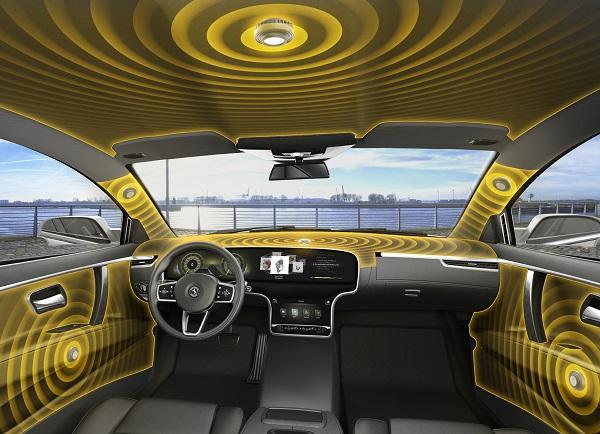Does Your Car Have Good Vibrations?

Most cars use loudspeakers to play back audio, but Continental envisions a "speakerless sound system" that instead of traditional transducers, uses interior trim panels to create sound. Your car already has a dashboard, instrument panel, door trim and a multitude of other interior bits and pieces. Why not set them oscillating (on purpose)?
According to Continental, actuators (voice coils, basically) could be bonded to interior pieces, which could play the role of speaker diaphragms. As with traditional speakers, the size of the pieces dictates the frequency band; for example, the A-pillar could be used for treble, door panels for midrange, and roof liner or rear package shelf for bass. Continental claims that a speakerless sound system would weigh less than 1 kilogram, and occupy only 1 liter or less; this is considerably less than a traditional car sound system that might weigh 15 kilograms and occupy anywhere from 10 to 30 liters. The technology even has a trendy name: Ac2ated Sound. You can read all about it in Continental's press release.
Devising speakerless speakers might seem like an exercise in reinventing the wheel; after all, the dynamic speaker was invented in 1925 and has stayed around because it works pretty well. Of course, speakerless technology has been around for a long time too, appearing in many various guises (remember NXT panels?). For example, Sony's A1E OLED television uses something called Sony Acoustic Surface Technology. Actuators on the back of the display panel yield mid/high sound (in conjunction with a traditional woofer). Sony even advises that the actuators can position the virtual sound source according to the action onscreen.
So, lets consider Continental's proposal. Its primary supposed benefit, I think, boils down to weight savings. Traditional speakers add considerable weight. But, even speakerless transducers have actuators, which would still require coils and magnets, which are the heavy part of any speaker. I am not sure how an entire speakerless system could weigh less than a kilogram.
Hmm, even thinking about this for 5 minutes, I see all kinds of devils in the details. Putting aside the basic question of fidelity, it would be tough to dial in soundstage and imaging, with different frequencies coming from various panels. And what happens if you touch the vibrating door panel, or lean something against it? And if a panel is designed to vibrate according to an actuator, how would it be isolated from road vibrations that would also vibrate it?
If Continental solves all those problems, and the system indeed saves a ton of weight, then car companies would be on board quickly because weight savings is a paramount goal for them. I only hope that car companies won't sacrifice sound quality in favor of weight savings. Overall, color me skeptical, but I'll reserve judgment until I hear a demo.
Meanwhile, next time you're driving your jalopy down a bumpy road, and twelve different trim pieces start buzzing, just remember — that's not a defect, it's a feature.


























































